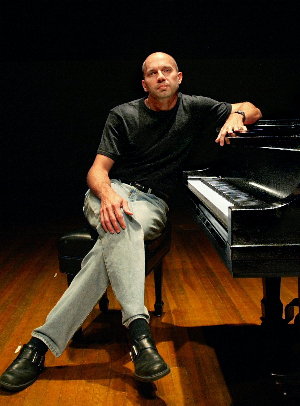Pianist Barnes brings audacious program to FIU

Pianist Paul Barnes perfomed a wide-ranging recital Sunday afternoon at FIU's Wertheim Concert Hall
A fascinating and audacious recital by pianist Paul Barnes drew only about fifteen audience members to Florida International University’s Wertheim Concert Hall Sunday afternoon.
A professor at the University of Nebraska, Barnes has specialized in the works of Liszt and Philip Glass, two composers who loomed large on his program. Important scores by Arvo Part and Samuel Barber completed the bill of fare. When a visiting artist presents such interesting repertoire in consistently arresting performances, one can only wonder why more of the university’s music students were not present.
Barnes opened with Arvo Part’s brief Fur Alina, a seminal 1976 work that established the composer’s unique blend of minimalism and spirituality. In a superbly controlled performance replete with striking tonal coloration, Barnes approached the score in an unabashedly romantic manner, drawing a flowing line and riveting emotion from every bar of this unique vignette.
Barber’s Ballade, Op.46 is one of that American master’s late works, dating from 1977. Melding the dark, edgy impulsiveness of Barber’s Piano Sonata with his expansive lyricism, this score is a twentieth-century reinvention of Chopin’s imaginative series of pieces in this genre. In Barnes’ lucid realization, the score resounded with impressive power and drama, the dynamic range travelling the full gamut from power pounding volleys to the softest pianissimos. This strong and effective work should be programmed more frequently.
Liszt’s Sonata in B minor is a familiar recital item but Barnes’ wildly impassioned performance made this pianistic evergreen sound like a new piece, easily besting Awadagin Pratt’s fine rendition at the Coral Gables Congregational Church concert series last summer. Barnes’ revisionist version uncovered episodes of dissonance and startling modernity. At times his performance sounded almost improvisatory, a boon in a score that can sound highly episodic.
While he played the agitated episodes twice as fast as most pianists, he was unafraid to linger over the romantic interludes. Barnes’ technical powers were impressively displayed as he unleashed fistfuls of notes across the extremes of the keyboard and dispatched hand crossings at daunting speed.. He gave equal weight to the yearning tenderness and bombastic fire of Liszt’s tour de force. Rarely has this score been served with such imagination and accomplished dexterity.
Barnes’ transcriptions of excerpts from Glass’ operas occupied the program’s second half, capped by the final movement of a concerto the pianist commissioned from the composer.
Barnes clearly reveres this American minimalist. While Glass’ music can sound merely repetitive in dutiful performances, Barnes’ sense of color and intensity shone new light on these excerpts. The finale from Glass’s Gandhi opera Satyagraha became a stirring pianistic etude, varied and exciting. The dance from Akhnaten was even more rousing, Barnes encompassing flurries of driving rhythmic patterns like a house a blaze.
Two pieces from Orphee, Glass’ operatic version of Jean Cocteau’s film script on the Orpheus legend, offered some of the composer’s most poetic, meditative music. The music of Orphee’ bedroom was surprisingly Gallic, spinning a wistful melody that would not have been out of place in a Ravel score. Orphee and the Prince sang in big boned, bravura voice with pianistic leaps and surging melody that spelled Rachmaninoff. Barnes’ elegant, beautifully expressive playing traversed this romantic side of Glass.
The Land, the finale from Glass’ Piano Concerto No. 2 (Lewis and Clark), is a virtuosic theme and variations that melds minimalism with Brahmsian grandeur. In addition to transcribing the orchestral part, Barnes wrote his own cadenza, a final display of fireworks by an artist of superb technical accomplishment and sensitive musicianship.
Posted in Performances, Uncategorized
4 Responses to “Pianist Barnes brings audacious program to FIU”
Leave a Comment
Mon Jan 17, 2011
at 12:17 am
4 Comments





Posted Jan 17, 2011 at 11:36 am by David
15 people at this recital, and about 1/3 capacity for the Toronto Symphony. Wow! Have all the music lovers in South Florida died off?
Posted Jan 17, 2011 at 7:04 pm by Stephen Malagodi
15 people in attendance? Not bad. About the same number as attended the opening of the FIU New Music Miami concert series on Saturday.
Here’s hoping the audience is better for the second concert of NMM, Feb. 19th with the legendary composer Pauline Oliveros. Not to be missed if you want an extraordinary and throughly enjoyable musical experience.
Posted Jan 18, 2011 at 10:18 am by Wolfgang731
I can’t even begin to wonder what happened with the Toronto concert at the Broward Center but I can only guess that two things may be responsible for the lackluster attendance at the FIU concerts. The first (and I believe primary reason) being it’s out of the way location and the second, lack of knowledge on behalf of the general public of the concerts taking place on campus. However, that stated, I think it’s pretty sad that the music school faculty and students should appear to be so unsupportive and apathetic.
Posted Jan 18, 2011 at 12:16 pm by Tammy A. Lapointe
May I suggest FIU invite Awadagin Pratt to perform? There will be far more in attendance – TRUST!!!